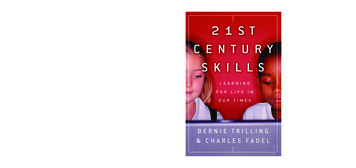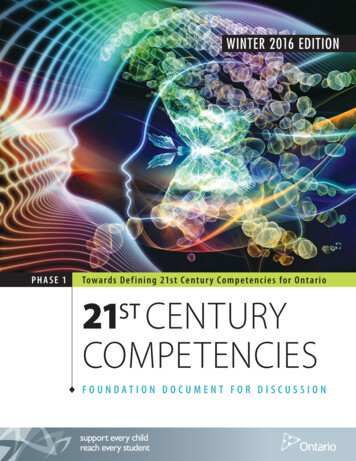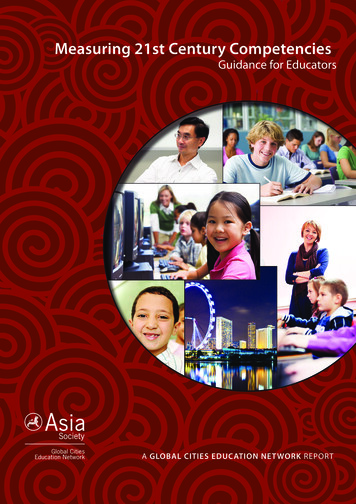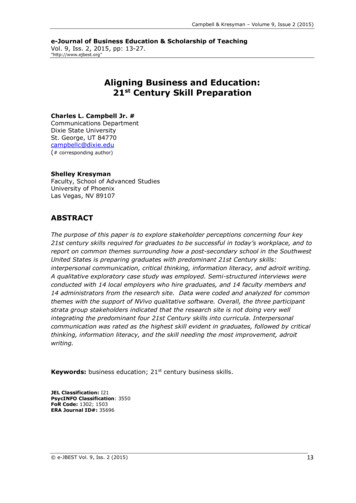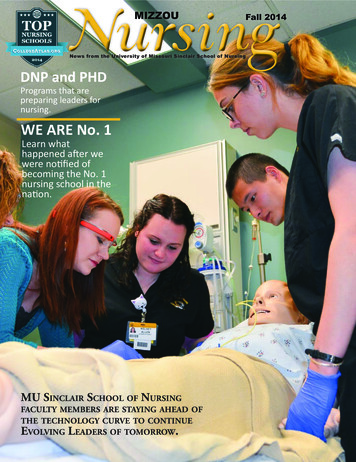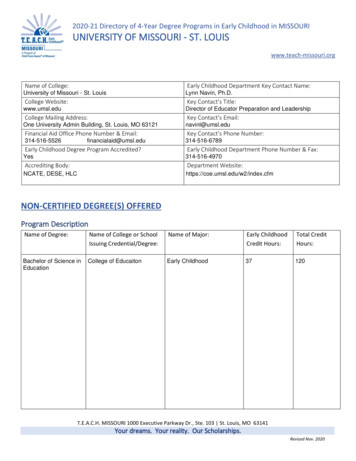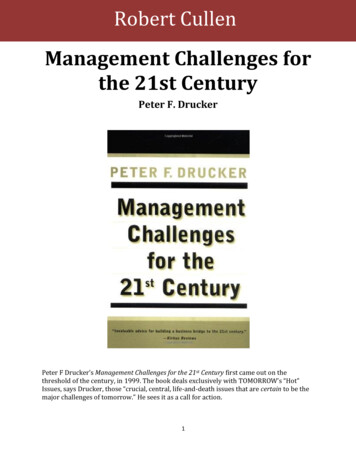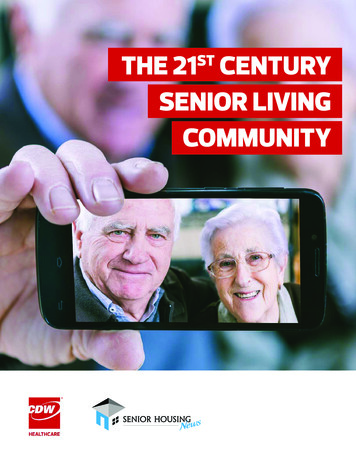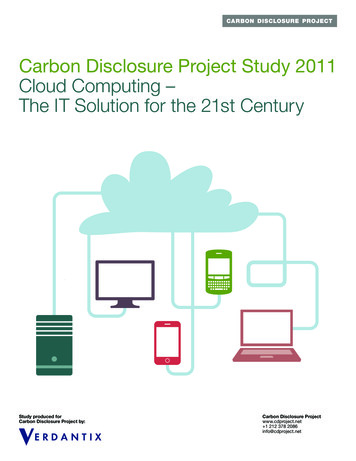
Transcription
Report of the21st Century Missouri Transportation System Task ForceRecommendations to support economic competitiveness, transportationreliability, and highway safetySubmitted to the General AssemblyJanuary 1, 2018
Report of the 21st Century Missouri Transportation Systems Task ForceRecommendations to support economic competitiveness,transportation reliability, and highway safetyTABLE OF CONTENTS1.02.03.0Executive Summary. 1The 21st Century Missouri Transportation System Task Force . 7What Missouri’s transportation system currently looks like . 93.1.What the 21st Century Missouri transportation system should look like . 113.2.Missouri’s aging transportation-infrastructure’s impact on economy . 134.0Missouri’s transportation system needs . 174.1The benefits—and costs—of a large-scale transportation system . 174.2Trends affecting Missouri transportation challenges and solutions. 194.3Missouri’s system needs – where the money goes . 254.4Unfunded transportation priorities in Missouri and how much it would cost to fund them . 274.5 Efforts by the Missouri Highways and Transportation Commission and MoDOT to efficiently meetMissouri’s transportation needs . 294.65.0Other state efforts to resolve Missouri’s system needs . 31Revenue options to address transportation system needs: other states’ experiences . 335.1States use a mix of funding sources today to address transportation needs . 345.2Long-term changes may require new funding sources . 355.3Changing conditions require sustainable funding . 376.0Current revenue sources for Missouri’s transportation revenue sources; uses and allocation 386.1Current revenue sources . 386.1.1State motor fuel taxes . 386.1.2Other state revenue sources . 396.1.3Federal motor fuel taxes . 396.1.4Other Federal Sources . 396.2Debt . 406.3Where the money goes . 41Page i6.3.1Initial allocations . 416.3.2The STIP process . 42Report of the 21st Century Missouri Transportation System Task Force
Recommendations to achieve a 21st Century transportation system . 447.07.17.2Immediate-Impact Investment (Part 1) . 457.1.1.Motor Fuels Tax Increase . 477.1.2Implement a dedicated multimodal revenue stream . 51Long-term sustainability and diversification of revenue streams (Part 2). 537.2.1Electric Vehicle and Hybrid Vehicle Fees; Electric-usage Fees . 547.2.2Increased Non-Fuel User Fees (License, Registrations, etc.) . 557.2.3Indexing User Fees . 557.2.4Motor Vehicle Registration Fee Schedule Revision . 567.2.5Internet Sales Tax Revenue for Transportation . 567.2.6Express/Managed Lanes. 577.2.7Major Bridge Tolling . 577.2.8Mileage-Based Road-User Charges . 587.2.9Local Revenue Sources and Flexibility. 597.2.9.1State Infrastructure Bank . 597.2.9.2Local Construction Excise Tax . 607.3 Legislative actions to improve transportation system, increase efficient project-delivery options,better leverage federal dollars, enhance highway safety, and encourage innovation (Part 3) . 608.07.3.1Project Delivery . 607.3.2Highway Safety . 617.3.3Innovation . 63Conclusion . 65Appendix A – House Concurrent Resolution 47 (2017)Appendix B – Task Force Member LettersAppendix C -- GlossaryPage iiReport of the 21st Century Missouri Transportation System Task Force
1.0Executive SummaryIn 2017, the General Assembly adopted HCR 47, which established the 21st Century MissouriTransportation System Task Force, a 23-member bipartisan panel comprised of participants from theHouse of Representatives, the Senate, the Executive Branch, and the private sector. The Task Forcewas directed to evaluate and make recommendations regarding our state transportation system andthe funding of that system. This report contains a summary of the Task Force’s activities and legislativerecommendations.The Task Force met 10 times throughout the state from June through December 2017. These publicmeetings enabled Missouri residents, elected officials, and civic and business leaders to discuss theirtransportation-related needs and concerns. The public hearings were well attended, with attendanceat each ranging between 80 and 175 persons. The Task Force heard informational presentations fromnational and local participants, learned about the condition and performance of area highways andbridges, and received public testimony from concerned Missourians. In all, more than 100 individualstestified on a variety of transportation issues.This report reflects the general consensus of the Task Force. Although not every recommendation issupported by every member, an effort was made to include in the report only recommendations thathad the general support of the Task Force members, based on the Task Force discussion in themeetings. Executive Branch members on the Task Force provided subject-matter expertise andinformation related to their constitutional roles of carrying out and enforcing the laws; however, theywere not asked to make specific policy recommendations. Still, each of the members’ experiencebased input to the Task Force was valuable.The Transportation System and Its ConditionTestimony to the transportation Task Force reinforced the extreme importance of Missouri'stransportation system. Our statewide system connects Missouri’s people with every vital part of theirlives: family, jobs, services and amenities. Manufacturers and farmers alike rely on the transportationsystem to get their products to market. For a business, the transportation system is the link betweentoday’s success and tomorrow’s opportunity that brings to them supplies, services and customers. Inshort, a safe, convenient, efficient, and reliable transportation system is vital to a prospering economy.Because of existing strengths, Missouri is poised (with strategic policymaking and proper investment)to have a world-class transportation and to be a leader in travel, logistics, and freight distribution.Missouri has a large system of road, highways, and bridges, including major interstate highwaycorridors that provide easy access for freight transportation. Business leaders testified to the TaskForce that leveraging Missouri’s geographic location, natural resources, and existing highway andintermodal systems through strategic policymaking and greater investment would substantially benefitthe economy, improve the quality of life for Missourians, and spur job growth. They also expressedPage 1Report of the 21st Century Missouri Transportation System Task Force
concerned, however, that unaddressed transportation-infrastructure needs will threaten economicgrowth for the state.The Task Force learned that Missouri has a large highway system that includes: 33,884 miles of roadway (America’s seventh-largest state highway system); and10,394 bridges (the sixth most nationally).The highway system is aging. The oldest stretches of the Interstate highway system in the state, forexample, were built in the 1950s with a 20-year life expectancy. Moreover, a large portion of statemaintained bridges have surpassed their 50-year design lives.The Task Force also heard how the aging and deteriorating transportation infrastructure is reducingsafety and constraining economic development. In a Report Card for Missouri’s Infrastructure,produced by of the American Society of Civil Engineers, the state earned an overall infrastructure gradeof a C minus. Related to transportation infrastructure, Missouri’s roads received a C, bridges received aC minus, aviation received a C, railroads received a C, and inland waterways received a D.The Task Force heard that highway safety in Missouri needs to be improved. MoDOT and the StateHighway Patrol have implemented designs and procedures that have improved highway safety, such asroad-shoulder rumble strips and median guard cables. But driver and passenger behavior continues toplay a significant role in traffic crashes and roadway deaths. There were 947 traffic fatalities onMissouri’s roadways in 2016—the highest number since 2008. Six out of ten people killed were notwearing seatbelts. Preliminary 2016 data also indicates cell phones were involved in 2,379 crashes—a23-percent increase since 2014. Driver inattention is the leading cause of traffic accidents in Missouri.Missouri ranks last among the states in preventable accidents by the National Safety Council in their2017 The State of Safety: A State-by-State Report. In the report, Missouri was one of seven statesreceiving an “F” rating and was ranked last of all 50 states and the District of Columbia.Funding the Transportation SystemTo pay for the transportation system, the State of Missouri draws on several revenue sources to raisethe approximately 2.5 billion spent on its transportation system, with nearly two-thirds of revenuecoming from state user fees and the other third coming from federal user fees.The revenue generated to support roads and bridges is allocated among the state (70%), cities (15%),and counties (15%) through a formula set forth in the Missouri Constitution. The Missouri StateHighway Patrol also receives transportation funding for administering and enforcing the state’s motorvehicles laws and traffic regulations.User fees constitute the primary sources of road revenue for management of the Missouri highwaysystem: fuel taxes, vehicle registration and driver licensing fees, and motor-vehicles sales taxes. InPage 2Report of the 21st Century Missouri Transportation System Task Force
fiscal year 2016, these revenue sources raised 2.468 billion (including state and federal sources).While this is a considerable sum, Missouri fares poorly in relation to other states. Missouri ranks just47th in the nation in revenue raised per mile.The largest source of user fee revenue comes from the 17-cent state motor fuel tax on each gallon ofgasoline and diesel purchased in Missouri. This motor fuel tax is a flat amount added to each gallon ofmotor fuel sold; the amount does not increase (or decrease) when fuel prices change. Missouri’s motorfuel tax is the fourth lowest among motor fuel taxes in the nation. It was last raised in 1996.Missourians pay a relatively small amount of direct costs per month (about 30) to use the statesystem of roads and bridges. But the effective monthly cost per driver—because of hiddentransportation costs in our underfunded system—is much higher. Such hidden costs include: Costs due to traffic congestion, including loss of productivity and opportunity, wasted fuel, andadverse effects on the quality of life;Costs in operating and maintaining a vehicle on rough roads, manifested in accelerated vehicledepreciation, additional vehicle-repair costs, increased fuel consumption, and increased tirewear; andCosts due to roadway crashes.Missouri now struggles with transportation funding largely because the principal revenue source fortransportation—the volume-based excise motor fuel tax—has continually lost purchasing power fordecades. Over the past 20 years, inflation has eroded the purchasing power of the 17-cents-per-gallontax to only eight cents today. This means that the excise fuel tax can purchase only 47 percent ofmaterials and labor necessary for road construction that it purchased in 1996, the last time the stateincreased its motor fuel tax. To account for inflation over the past 20 years, the motor fuel tax wouldhave to be 27 cents today in order for it to have the same purchasing power as it did in 1996.Most states, like Missouri, have for decades relied substantially on revenue from the motor fuel tax tofund transportation-infrastructure needs. Although the motor fuel tax has been an accurate proxy forhighway usage, its long-term sustainability as the primary transportation-revenue source will bechallenged due to the move towards high-efficiency vehicles, changing travel patterns, and electric oralternative fuels.The Task Force learned that long-term funding neglect and shortfalls have left the state withapproximately 825 million worth of unfunded transportation priorities annually. This gap means that: Page 3Roads and bridges aren’t being improved sufficiently;The transportation system isn’t as safe as it could be;Economic growth is being stifled;Travelers too often are delayed because of traffic congestion;Interstate highways need to be reconstructed but instead are merely maintained;Report of the 21st Century Missouri Transportation System Task Force
Multimodal transportation options are neither enhanced nor increased.The Task Force heard testimony that there is no “silver bullet” for funding the statewide transportationneeds of today and that other states are using a diverse mix of revenue options to fund theirtransportation system improvements. This has been in response to declining federal funding support,rising construction and materials costs for needed transportation improvements, and the growingrecognition that fuel taxes alone cannot address statewide transportation needs adequately.In Washington D.C., 2017 heard conversations about a potential additional investment intransportation infrastructure, but little action was taken. The President and congressional leaders haveexpressed hope, though, that infrastructure will be a priority in 2018. In all the possible scenarios beingmentioned, the general consensus is that states will have to come up with more matching dollars thanthey had to in the past to access federal dollars. States thus need to be ready with projects and statematching dollars. They’ll need to explore new policies and approaches that leverage private-sectorresources to fund and deliver important transportation projects.Recommendations for Improving Transportation System: A 3-Part RoadmapFor more than six months, the 21st Century Missouri Transportation System Task Force talked withMissouri residents, taxpayers, business leaders, and transportation experts about a broad range oftopics and issues related to our transportation system. It is clear from this ongoing statewideconversation that Missourians—and the Task Force—recognize that we need to invest more in ourstate transportation system in order to develop the modern, world-class transportation system thatMissourians want and need.Acting on the input provided to it in 2017, the Task Force has developed a three-part roadmap forfunding and improving Missouri’s transportation system. The roadmap envisions sets of short- andlong-term strategies and steps for building and acting on a consensus around what that system lookslike, how it operates, and how it should be funded. Meanwhile, the roadmap also calls for legislativeaction to improve highway safety and to improve our ability to better leverage existing transportationfunding and emerging opportunities and innovations.Part 1: Immediate-Impact InvestmentAn immediate investment package would involve stabilizing Missouri’s transportation-system fundingand making the transportation safer and more economically beneficial. The Task Force’srecommendations would address immediate needs in the highway system and in multimodaltransportation, while policy options for dealing with longer-term challenges are developed andimplemented.At every Task Force meeting, citizens and civic and business leaders provided public testimony thatsupported increased transportation funding. And an increase to the motor fuel tax was most oftenPage 4Report of the 21st Century Missouri Transportation System Task Force
cited as the best short-term solution. Missouri’s current motor fuel ta is the 4th lowest in the nation.The proposed increase would still keep Missouri competitive with surrounding states and nationally.To improve roads and bridges in Missouri, the Task Force recommends increasing the state excise taxon gasoline by 10 cents and on diesel by 12 cents per gallon. These adjustments would correct theinflation-driven value loss that has occurred since the motor fuel tax was last raised in Missouri. Thisadditional investment by highway users would raise approximately 430 million annually to improveour roads and bridges. This would generate a total of approximately 4.3 billion over 10 years.In addition, the Task Force recommends implementing a dedicated revenue stream of 50- 70 millionannually for the state’s multimodal transportation needs (i.e., aviation, mass transportation, railroads,ports, waterways, waterborne commerce, and transportation of elderly and disabled persons). TheTask Force recommends that the legislature look at potential, dedicated funding options formultimodal transportation that would involve no additional taxation of Missouri citizens.Part 2: Sustainable and diversified transportation funding for the futureMissouri is confronted with an unprecedented amount of potential change as we plan for ourtransportation needs over the next 20 years and beyond. We need to anticipate the future landscapeand decide how best to address the challenges and opportunities presented by increasing fuelefficiency and the emergence of automated, connected, electric, and shared-use vehicles, andcomplementary technologies and the impact they’ll have on our transportation network and fundingsources.The Task Force heard from several presenters who shared that, because of these long-term fundingsustainability considerations, states are actively evaluating or implementing new revenue options.These include road-user charges or vehicle-miles-traveled (“VMT”) fees; tolling and congestion pricingthrough express managed lanes; leveraging private investment through public private partnerships;electric and hybrid vehicle fees and charges; indexing fuel with inflation, among many other new andemerging revenue options.The Task Force recommends that the General Assembly consider many options for developing andimplementing more sustainable and diversified transportation revenue. These include: Page 5Increased registration fees for electric vehicles;Excise fees or taxes on electric charging stations and systems;Increases to on non-fuel transportation user fees (driver’s licenses, vehicle registrations, etc.)which haven’t been adjusted since at least the 1980s;Index highway-user fees (e.g., motor fuel tax, licensing & registration, etc.) to account forinflation;Revise the vehicle-registration schedule to be based on fuel efficiency (MPG) instead of onhorsepower;Report of the 21st Century Missouri Transportation System Task Force
Dedicate a portion of revenue from sales taxes on internet purchases for transportationpurposes;Utilize optional express managed lanes on highways in metro areas to increase capacity, reducecongestion, and improve travel reliability;Consider better authorization for tolling on major bridges to pay for needed construction;Consider mileage-based road-user charges;Further capitalize the state infrastructure bank; andEnable local construction excise taxes.Part 3: More Efficient Project Delivery; Improved Highway Safety; and InnovationThe Task Force encourages the General Assembly to explore transportation methods for projectdelivery that involve innovative partnerships and solutions. For example, states are using a variety ofpublic private partnerships to improve efficiency to enable larger, more transformative projects to becompleted faster and more economically by leveraging private-sector investment and involvement.To improve safety on Missouri highways, the Task Force recommends legislation to: Prohibit distracted driving (in particular, texting while driving);Require seat belt use, enforced as a primary offense; andProvide more graduated driver’s-license training requirements for young drivers.Finally, the Task Force recommends that the Missouri legislature examine opportunities to leverageinnovation in transportation to help grow the state’s economic competitive advantage and improvethe quality of life of Missouri’s citizens.Page 6Report of the 21st Century Missouri Transportation System Task Force
2.0The 21st Century Missouri Transportation System Task ForceThe Missouri General Assembly in 2017 established the 21st Century Missouri Transportation SystemTask Force to answer a fundamental question:What kind of state transportation system must we provide and fund to deliver the safety,economic vitality, and quality of life Missouri residents and businesses need to succeedpersonally and economically?This is a question Missouri has struggled to answer for many years. As Missouri’s transportationinfrastructure has been aging, alarms have been raised by the Missouri Department of Transportation(MoDOT), citizens, business groups, and legislators regarding potential impacts of long-term threats tothe state’s ability to design, build, and sustain an effective, efficient transportation system. Severalfactors contribute to this concern, including: Stagnant state motor fuel tax revenue;Lagging federal infrastructure revenue;Increasing construction, maintenance and fuel costs; andTransportation innovations requiring new investments while threatening the sustainabilityof traditional funding sources.Over the past decade, there has been much discussion yet little resolution about how best to addressMissouri’s changing and expanding transportation needs. The state’s 99th General Assembly hoped toaddress this when it adopted House Concurrent Resolution No. 47.1 HCR 47 established the 21stCentury Missouri Transportation System Task Force,2 a 23-member panel comprised of participantsrepresenting the legislative Branch, the executive branch, and the private sector. More specifically, thebipartisan panel includes five state senators, five state representatives, the governor (or his designee),the director of economic development, the superintendent of the highway patrol, the director oftransportation, and nine Missouri private-sector representatives.The members of the 21st Century Missouri Transportation System Task Force are:Representative Kevin Corlew, ChairSenator Dave Schatz, Vice-ChairSenator Shalonn “Kiki” CurlsSenator Bill EigelSenator Jacob Hummel1HCR 47 is attached as Appendix A. See also illspdf/2324H.02C.pdf (lastvisited December 27, 2017).2The members of the Task Force are listed in this section of the report. See alsohttp://house.mo.gov/Committees.aspx?category all&year 2018&code 1 (last accessed Jan. 1, 2018);http://www.senate.mo.gov/mttf/ (accessed December 18, 2017).Page 7Report of the 21st Century Missouri Transportation System Task Force
Representative Greg RazerRepresentative Bill ReiboldtSenator Caleb RowdenRepresentative Joe RunionsRepresentative Nate TateGovernor Eric Greitens3Director Patrick McKenna, Missouri Department of TransportationDirector Rob Dixon, Missouri Department of Economic DevelopmentColonel Sandra Karsten, Missouri State Highway PatrolRudolph Farber (appointed by Senate President Pro Tem)Steve Halter (appointed by Speaker of the House)David Hogan (appointed by Governor)Gretchen Ivy (appointed by Speaker of the House)Nathan McKean (appointed by Governor)Gwen Moore (appointed by House Minority Floor Leader)Craig Porter (appointed by Governor)Thomas Schneider, Mayor, Florissant (appointed by Senate Minority Floor Leader)Dale Williams (appointed by Senate President Pro Tem)The Task Force was charged with reporting its activities, findings and any legislative recommendationsto the General Assembly by January 1, 2018. Specifically, the Task Force was assigned to:1. Evaluate the condition of the state highway system, including roads and bridges;2. Evaluate current transportation funding in Missouri;3. Evaluate whether current transportation funding in Missouri is sufficient to not onlymaintain the highway system in its current state but also to ensure that it serves thetransportation needs of Missouri’s citizens as we move forward in the 21 st century;4. Make recommendations regarding the condition of the state highway system; and5. Make recommendations regarding transportation funding.The Task Force held seven public hearings and three working sessions throughout the state from Junethrough December 2018: June 28 -- Jefferson City, MO (Capitol);July 26 -- Kansas City, MO (Greater KC Chamber of Commerce, Union Station);August 23 -- Springfield, MO (Springfield Chamber of Commerce);September 20 -- Kirksville, MO (Truman State University);October 11 -- Jefferson City, MO (Capitol) (working meeting);October 18 – St. Louis, MO (St Louis Community College – Meramec Campus);November 8 – Jefferson City, MO (Capitol) (working meeting);3The Governor was represented in Task Force meetings by Will Scharf, Policy Director, and Logan Spena, Deputy PolicyDirector.Page 8Report of the 21st Century Missouri Transportation System Task Force
November 15 – Cape Girardeau, MO (Drury Plaza Convention Ctr., hosted by the CapeGirardeau Area Chamber of Commerce and the SEMO Port);December 13 – Columbia, MO (Stoney Creek Conf. Ctr., hosted by the Columbia Chamber ofCommerce); andDecember 19 – Jefferson City, MO (Capitol) (working meeting).These public meetings enabled Missouri residents, elected officials, and civic and business leaders todiscuss their transportation-related needs and concerns. The public hearings were well attended, withattendance at each ranging between 80 and 175 persons. The Task Force heard informationalpresentations from national and local participants, learned about the condition and performance ofarea highways and bridges from MoDOT regional district engineers, and received public testimonyfrom concerned Missourians. In all, more than 100 individuals testified on a variety of transportationissues.This report reflects the general consensus of the Task Force. Although not every recommendation issupported by every member, an effort was made to include in the report only recommendations thathad the general support of the Task Force members, based on the Task Force discussion in themeetings. Executive Branch members on the Task Force provided subject-matter expertise andinformation related to their constitutional roles of carrying out and enforcing the laws; however, theywere not asked to make specific policy recommendations. Still, each of the members’ experiencebased input to the Task Force was of great value to Task Force deliberations. In addition, each TaskForce member was given the optional opportunity to attach a one- to two-page letter to the reportwith any additional comments the member would like t
Page 1 Report of the 21st Century Missouri Transportation System Task Force 1.0 Executive Summary In 2017, the General Assembly adopted HCR 47, which established the 21st Century Missouri Transportation System Task Force, a 23-member bipartisan panel comprised of participants from the House of Representatives, the Senate, the Executive Branch, and the private sector.

